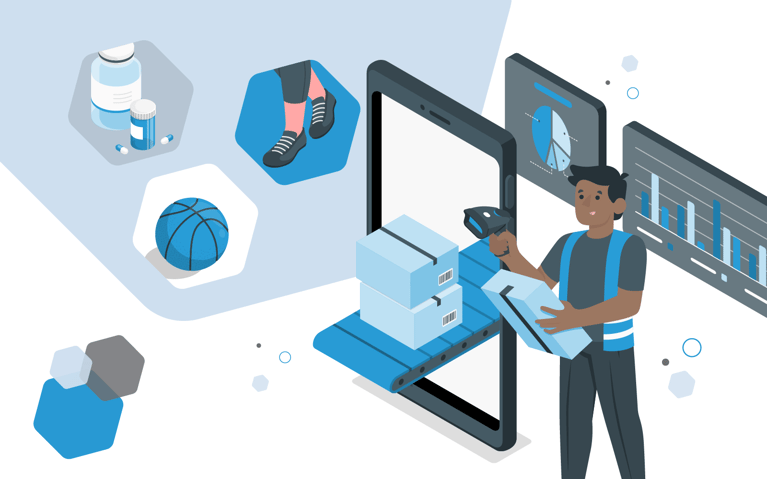The retail world is constantly evolving – technology progresses, and buyer behaviors shift frequently. Each new year is an opportunity to recalibrate your retail marketing, brand and fulfillment strategies so you can implement retail trends that enhance the customer experience. This article explores key marketing, brand and fulfillment insights and provides the steps necessary to plan and achieve retail success in 2024.
Dig into data: Analyzing customer behavior and preferences
Retail brands that want to leverage powerful marketing trends like automation and storytelling must tailor their strategy and sales approach to fit their unique customer base. The best way to discover your customers and their journey is to analyze behavior. You should regularly take time to dive into customer data points, including past purchases, browsing history, preferences and survey feedback. You can also gather information from your sales team to identify common pain points or FAQs. If you want to go a step further, analyze the broader retail industry and competitors to stay on top of trends and successful strategies.
Personalizing
Using these pieces of data, marketers can craft personalized marketing experiences that suggest related products and create highly relevant messaging for each customer segment. Retailers can even create special discount offers tailored to customer buying patterns to foster a sense of exclusivity. Your website, social media and email marketing work together to deliver content that aligns with customer interests.
As with all marketing, personalized marketing requires constant data analysis. Build time into your schedule to dive into the data and pivot your marketing strategies as necessary to facilitate your intended outcomes.
Technology trends: Leveraging MarTech
The digital marketplace requires consistent adaptation and implementation of MarTech tools. As 2024 arrives, retailers must look at trends that customers and competitors have adopted – or be left behind.
In the past year, AI has burst onto the scene along with better integrations, the rise of social selling, and a new and improved level of personalization. Not only do these MarTech trends improve the customer experience, but they can also benefit brands, allowing them to streamline, strategize better and reduce manual labor.
Automation
Marketing automation lets you automate tasks and workflows related to:
- The sales process
- Prospecting
- Customer profiling
- Lead nurturing
- Customer engagement
Imagine that you have an interested consumer browsing your site. They add items to their cart – and then walk away. Automation can trigger any number of events in this scenario. If the customer has provided information, they may receive an email letting them know they left something in their cart and give a 10% discount to finish the transaction.
Automation can do much more. From scheduling content and posts to creating segmented lists, retailers can hyper-target behavior and engage customers more deeply.
Augmented reality
There were over 254 million online buyers in 2023 – and the ecommerce industry is projected to keep growing at a rapid rate. Brands are finding innovative ways to enhance the online shopping experience, including AI and augmented reality.
These tools help consumers visualize products and interact with them. It increases engagement and, in turn, can increase conversion rates. For retailers that primarily or solely sell online, augmented reality is beneficial.
Social commerce
Browsing and shopping directly through social media platforms is becoming increasingly popular. And brands are getting savvier in how they connect with customers. From live shopping events on TikTok to creator content that bolsters product discovery, social platforms are becoming a one-stop shop. Social platforms have also risen to the occasion, offering new tools and integrations to make social commerce easier.
Personalized marketing experiences
An intentional and well-thought-out marketing strategy is critical in a time of numerous product options and easy access to ecommerce merchants around the globe. Cutting through the noise takes focusing on creating deeper connections with consumers. Personalization in online marketing can bring authenticity to brand engagements and help you craft a more memorable customer experience. Personalizing involves actions that include segmenting, recommending and targeted content.
Deeper brand engagement: Building a strong brand identity in a crowded market
Creating high-quality products that meet a specific customer need is only half the battle in 2024. There are bound to be several competing versions of any given product, even within a specific niche. The best way to get your top-tier product in front of customers is to build a strong brand identity they can remember and return to.
Differentiating your business through a strong brand identity involves paying special attention to the way your customers feel, not just what you’re selling. A well-defined brand identity encompasses your values, personality and brand's unique story. This is distinctive to you and resonates with consumers, creating a lasting impression beyond the transactional nature of retail.
Creating exceptional experiences
On top of building a memorable brand through storytelling and an emphasis on values, retail brands need to nurture customer loyalty through exceptional experiences. Having a memorable brand isn’t helpful if customers don’t associate your brand with above-and-beyond service and quality. This includes:
- Exceptional customer service
- Personalized interactions
- Frictionless shopping and checkout experiences
- Seamless shipping and returns
Your efforts contribute to building trust and fostering long-term relationships. From creating smooth return policies to increasing customer service availability during busy seasons, making the customer experience as easy and pleasant as possible is crucial. Each touchpoint – from the first interaction to post-purchase support – shapes the customer's perception of your brand and influences their decision to remain loyal.
It’s also important to remember that customer expectations can change over time. As such, successful retailers are agile in responding to these changes, adjusting their brand strategies to align with what matters most to their target audience. This adaptability requires a keen understanding of market trends, proactive engagement with customer feedback and a commitment to continuous improvement.
Optimized fulfillment: Streamlining the shipping and returns processes
The growth of ecommerce has fueled the need for a reliable and fast supply chain. Online retailers rely on warehouses, fulfillment center and carriers to get products to customers in tight timeframes. The demand for same-day, two- and three-day shipping puts pressure on brands to partner with the right companies – making your 2024 fulfillment strategy crucial to retail success.
Fulfillment trends to watch
Logistics and fulfillment have dived headfirst into the era of digital transformation. Getting the supply chain online offers numerous benefits. In 2024, ecommerce retailers should look for partners on the forefront of fulfillment trends to remain competitive.
Digitalization provides more strategic data for decision-makers, enhances visibility and helps ecommerce brands communicate more clearly with customers. With the right data, brands can identify areas for improvement, from stock replenishment to multi-node fulfillment.
Fulfillment strategies to consider
When creating your retail plan and strategies for 2024, think about the following items:
- Shipping speeds and cost: What strategy will optimize your timeframe while keeping it cost-effective?
- Returns management: Is your returns policy clear? Are returns easy for customers?
- Fulfillment: Do you have a fulfillment strategy? Is it scalable? Does it fit your needs? Do you have optimal visibility?
- Inventory management: What inventory challenges do you have? Is your product near your customer base? Do you have excess inventory or not enough? How do you handle stock replenishment?
Become a thriving ecommerce retail brand in 2024
As technology advances at breakneck speed and innovations like automation and AI permeate the retail world, staying adaptable will be a key to success in 2024. Plan your marketing, branding and fulfillment strategically and make adjustments throughout the year. By incorporating the latest trends in retail marketing, embracing proven strategies and staying attuned to consumer needs, you'll be well on your way to a successful year.
Subscribe to our emails for the latest industry insights!
By entering your email, you agree to receive marketing emails from Cart.com






